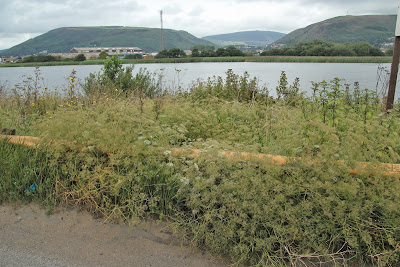+(03a).jpg) |
Longleaf growing dockside, very close to the
Rough Star-thistle (Centaurea aspera) site |
+(05a).jpg) |
| Longleaf flowers |
As with Dunnock (
Prunella modularis) and Selfheal (
Prunella vulgaris),
Longleaf (
Falcaria vulgaris) shares its generic name with another totally unrelated organism, the moth Scalloped Hook-tip (
Falcaria lacertinaria). The Flora of Glamorgan states this neophyte was last recorded in West Glamorgan in 1909 at Port Talbot. Being a rhizomatous perennial, it appeared that the 13m x 3m patch I stumbled across today has been there a long time, but whether the population is the same as the 1909 site is not known. Given the apparent prolific seed production, perhaps it's more likely the species has persisted as small colonies on and off in the area.
Longleaf leaves (left) and Oak-leaved Goosefoot (right)
Other noteworthy plant sightings recently have included
Bugseed (
Corispermum intermedium) at Margam Tip and
Oak-leaved Goosefoot (
Chenopodium glaucum) in Swansea Docks. Although both are non-natives and hence of limited ecological significance, they have very restricted distributions in Wales and are of local interest.
+10aug13+(1a).jpg) |
the rather uninspiring Bugseed,
naturalised at only a handful of UK sites |
+(03a).jpg)
+(05a).jpg)
+10aug13+(1a).jpg)

+(09a).jpg)
+(7a).jpg)
3 comments:
Nice record Barry. But, is Longleaf rhizomatous? In the southern parts of its Eurasian range it is often monocarpic (annual or biennial). In Britain it tends to be perennial, producing a stout tap root, but probably fairly short-lived. If the Port Talbot population is rhizomatous, that is very interesting! The population probably relies on good seed production for longevity. Judging from your photo, it is doing very well this year, probably benefitting from the ideal growing conditions for thermophilic species this summer.
What a great find Barry - well done! Shows how interesting urban botanising can be! I`ve always thought that western Glamorgan has n`t received the amount of attention that its urban/brownfield areas really deserved, but thanks to you and Charles, matters are changing. Liked the rye broom blog too - interesting.
Charles, according to the New Atlas it's rhizomatous. The population seems well established in a reasonable stable rough sward, but I can't imagine how this site must have changed over the last 100 years! I've been keeping an eye open for it elsewhere since but so far without success.
Post a Comment